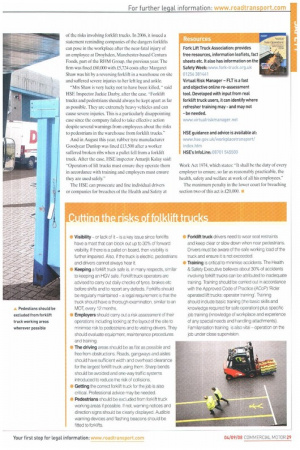Visibility -or lack of it is a key issue since forklfts
Page 29

If you've noticed an error in this article please click here to report it so we can fix it.
have a mast that can block out up to 30% of forward visibility. If there is a pallet on board, then visibility is further impaired. Also, if the truck is electric, pedestrians and drivers cannot always hear it.
• Keeping a forklift truck safe is, in many respects, similar to keeping an HGV safe. Forklift truck operators are advised to carry out daily checks of tyres, brakes etc before shifts and to report any defects. Forklifts should be regularly maintained a legal requirement is that the truck should have a thorough examination, similar to an MOT, every 12 months.
• Employers should carry out a risk assessment of their operations including looking at the layout of the site to minimise risk to pedestrians and to visiting drivers. They should evaluate equipment, maintenance procedures and training.
• The driving areas should be as flat as possible and free from obstructions. Roads, gangways and aisles should have sufficient width and overhead clearance for the largest forklift truck using them. Sharp bends should be avoided and one-way traffic systems introduced to reduce the risk of collisions.
Getting the correct forklift truck for the job is also critical. Professional advice may be needed. Pedestrians should be excluded from forklift truck working areas if possible. If not, warning notices and direction signs should be clearly displayed. Audible warning devices and flashing beacons should be fitted to forklifts. • Forklift truck drivers need to wear seat restraints and keep clear or slow down when near pedestrians. Drivers must be aware of the safe working load of the truck and ensure it is not exceeded.
• Training is critical to minimise accidents. The Health & Safety Executive believes about 30% of accidents involving forklift trucks can be attributed to inadequate training. Training should be carried out in accordance with the Approved Code of Practice (ACoP) 'Rider operated lift trucks: operator training'. Training should include basic training (the basic skills and knowledge required for safe operation) plus specific job training (knowledge of workplace and experience of any special needs and handling attachments). Familiarisation training is also vital operation on the job under close supervision.




































































































































































